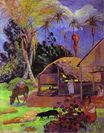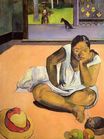Paul Gauguin - Come here 1891
 |
 |
 |
 |
 |
 |
 |

Come here 1891
72x91cm oil/canvas
Solomon R. Guggenheim Museum, New York, USA
The image is only being used for informational and educational purposes
<< Previous G a l l e r y Next >>
From Solomon R. Guggenheim Museum:
Prior to his first voyage to Tahiti in 1891, Paul Gauguin claimed that he was fleeing France in order “to immerse myself in virgin nature, see no one but savages, live their life, with no other thoughts in mind but to render the way a child would . . . and to do this with nothing but the primitive means of art, the only means that are good and true.” Gauguin’s desire to reject Western culture and merge with a naive society for the sake of aesthetic and spiritual inspiration reflects the complex and problematic nature of European “Primitivism.” A concept that emerged at the end of the 19th century, “primitivism” was motivated by the romantic desire to discover an unsullied paradise hidden within the “uncivilized” world, as well as by a fascination with what was perceived as the raw, unmediated sensuality of cultural artifacts. This voyeuristic engagement with underdeveloped societies by artists, writers, and philosophers corresponded to French imperialistic practices—Tahiti, for example, was annexed as a colony in 1881.
Nancy Spector